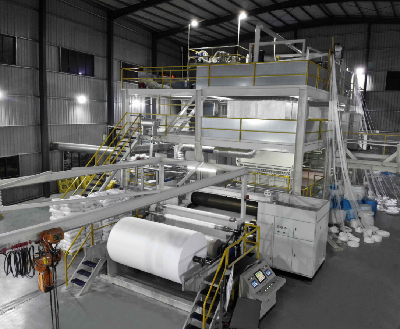With the continuous development of the textile industry, the development of woven fabrics has gradually matured, but the requirements for fabrics are constantly improving. Therefore, in recent years, non-woven fabrics, as part of the textile industry, have also begun to flourish. Suntech has been committed to the textile machinery industry for more than 50 years. We have very rich experience in the machinery of the weaving industry, but at the same time we are also committed to the innovation and development of non-woven machinery. So before learning the non woven machines, we also need to know what is non-woven fabric.

SUNTECH nonwoven fabric machine
Definition of Non-woven Fabric
Woven fabric is different from woven fabric, Woven fabric is any textile formed by weaving. Woven fabrics are often created on a loom, and made of many threads woven on a warp and a weft. Textile products formed by industrial processes. The separate fibers can be preferentially oriented in one direction, or can be combined in a random fashion. They are bonded into textiles by chemical, thermal or mechanical processes. Nonwovens are mainly flat structures. This relatively young branch of nonwovens has been greatly developed in the 20th century due to the fact that the production process of nonwovens differs from traditional textile processes with high productivity and resulting cost savings.
Modern nonwovens date back to the early 1930s. At the time, some textile companies began experimenting with adhesive materials to reuse cotton waste. The first commercial production of what is now called nonwovens began in the United States in 1942 with the aim of producing fabrics directly from fibers. The nonwoven products market has experienced tremendous growth and has greater potential.
Nonwovens can be classified as either disposable or durable. Disposable or non-durable nonwovens are more inclined to be used in products used in the hygiene and medical industries, such as masks, medical protective clothing, medical curtains, household wipes, diapers, sanitary napkins, etc. Durables are used in clothing liners, automotive fabrics, geotextiles, carpets, sound insulation, and more.
Raw Materials
Because of its high productivity, non-woven fabrics are also different from the traditional textile industry in the use of raw materials. Natural fiber materials such as cotton and linen are the raw materials of the traditional textile industry, while non-woven fabrics are more commonly used synthetic fiber materials, similar to Polyester (PES), polypropylene (PP), polyamide, rayon, etc., raw materials not only bring significant product improvements, but also benefit the people who use these products by providing hygiene and comfort.
Synthetic fibers are selected based on their properties and expected properties for the end use. Through different processing techniques, synthetic fibers can be drawn into short fibers and filament fibers. Due to the requirements of different fabric characteristics, fibers of different lengths and different types of fibers can be mixed to achieve the characteristics of different fabrics. As with the manufacture of all fabrics, the cost of the fibers used is important because it in turn affects the cost of the final product.
Characteristics and Uses of Non-Woven Fabric
Because of the different production processes of non-woven fabrics, they can produce fabrics with different characteristics, so the characteristics of non-woven fabrics are also different, which also leads to a wide range of applications of non-woven fabrics.
1.The appearance of non-woven fabrics is paper-like, felt-like or similar to woven fabrics, so it has a variety of applications.
2. They can be very soft and stretchy, or they can be hard, rigid or wide with little flexibility. So it can be used both in the hygiene and medical German industry, as well as in industrial fabrics, similar to geotextiles, etc.
3. Some fabrics have excellent washability and can be used to produce some durable nonwovens, including household and household items such as curtains, upholstery, mattress pads, towels, tablecloths, blankets and carpet backings as well as apparel and Apparel such as hats, liners, liners, seams and other reinforcement fabrics.




